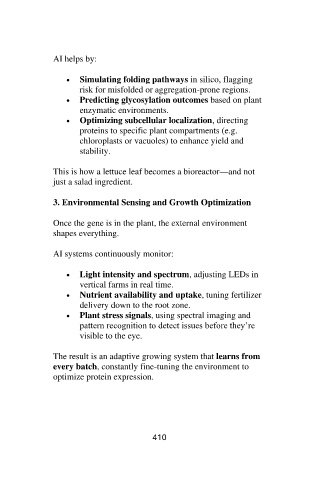Page 412 - Binder2
P. 412
AI helps by:
• Simulating folding pathways in silico, flagging
risk for misfolded or aggregation-prone regions.
• Predicting glycosylation outcomes based on plant
enzymatic environments.
• Optimizing subcellular localization, directing
proteins to specific plant compartments (e.g.
chloroplasts or vacuoles) to enhance yield and
stability.
This is how a lettuce leaf becomes a bioreactor—and not
just a salad ingredient.
3. Environmental Sensing and Growth Optimization
Once the gene is in the plant, the external environment
shapes everything.
AI systems continuously monitor:
• Light intensity and spectrum, adjusting LEDs in
vertical farms in real time.
• Nutrient availability and uptake, tuning fertilizer
delivery down to the root zone.
• Plant stress signals, using spectral imaging and
pattern recognition to detect issues before they’re
visible to the eye.
The result is an adaptive growing system that learns from
every batch, constantly fine-tuning the environment to
optimize protein expression.
410

